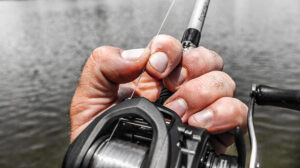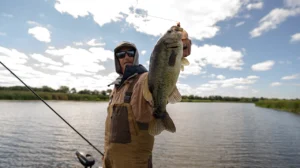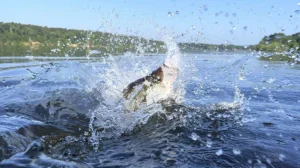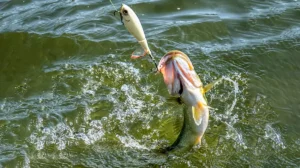It’s cold out. Some of us have colds. The water burns your hands it’s so cold. So fishing this time of year on open water can be painful. Anglers should maximize their chances with a few simple tips to make the most of some of the toughest fishing of the year.
1. Quick and steep
Most bass will spend their time deep in the winter. Deep is obviously relative to the body of water, but they will occasionally come shallow even in the winter. The best bet to find coldwater bass is to fish steep banks. Deep doesn’t necessarily mean far from the bank. So focus on 45-degree banks to straight bluffs. Hopping a jig, swimming a grub, yo-yoing a blade bait can all produce in these areas as can a suspended jerkbait or jigging spoon.
2. Taunting not teasing
This time of year bass are not running down baits from 10 yards away. They don’t react well to baits blazing by them. You can tease them as well with a burst of speed or quick hops like in the spring and summer. Instead get a mental picture of a bass down there right above your bait, just watching it. You’ve got to hold it in his face and taunt him until he can’t stand it anymore. He’s not looking to run something down because he’s hungry. He’ll bite because he’s curious or tired of looking at it.
A jig crawled painfully over each individual pebble, a jerkbait suspended with long pauses, and even a jigging spoon with small 4-6 inch jerks in one spot can turn an onlooker into a biter.
3. Minute maneuvers
This is similar to the taunting, but be sure to focus on imparting minimal action. A jigging spoon jerked 4 feet off the bottom in the summer works wonderfully on deep clear reservoirs, but that same spoon should be jerked just inches off the bottom in the winter. A jerkbait with a twitch-twitch-pause cadence in the spring is deadly, but a slower pull and pause is often better in the winter. Minimize the movements of the bait to tempt in one spot longer. Ice fishing guys call this pounding.
4. Avoid cold fronts
This sounds obvious, but I learned a hard lesson last weekend. I was too busy with, well writing these blogs, to fish when it was 60+ degrees on Friday. Then my batteries were dead when it was 45 degrees on Saturday. By Sunday it was a balmy 25 degrees out and the fish had gotten progressively more stubborn. Instead of doing what I did, watch the weather, and if at all possible, fish when you have several sunny days in a row or even better when the days are warming consecutively. That can often clue fish into a feed.
5. Warm rain is your friend
One of the best days I first had on Kentucky Lake was in early February several years ago. We had several warm days of rain, like 60- to 65-degree days. That was 60- to 65-degree water being dumped into a lake that was full of 45-degree water. I thought some of the areas that had water running into the lake would be warmer. As luck would have it, I found two drains coming into one stretch of creek.
I mopped up the bass with a Rapala Shad Rap, including several 5-pounders and a couple of bigger ones that didn’t make it all the way into the boat. You have to know your fishery or do some searching, but if you can find where warm rain is coming into the lake, you can find bass migrating into the warmer water areas and setting up on predictable cover like rip rap, laydowns, stumps and docks.









